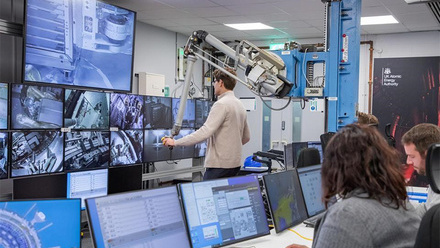Venture forth
How students can hone their entrepreneurial skills.

Interest in entrepreneurship has gained a lot of momentum from exposure on shows like Dragons Den and The Apprentice. However, entrepreneurship, and especially technology entrepreneurship, is not easy – with data suggesting 50% of all new businesses fail within their first three years.
Nevertheless, with increased awareness about what it takes to get a scientific venture to market, if you are a student with an interesting idea, starting a business can be a satisfying way of helping others. By getting a useful product to market, you can forge your own career without a boss or corporate structure.
Even if it fails, the experience can be useful and is unlikely to put off potential employers if you decide instead to enter employment.
A springboard
Materials science is a great starting point for a business as it is key to solving many important world issues – not least around healthcare, energy storage, transport, building materials, clothing and plastics.
Indeed materials science contributes to several of the UN Sustainable Development Goals – and student and staff businesses can contribute to a university’s world ranking for this.
But with the resources and skills needed, starting a business can seem daunting – so what steps can you take to start your journey?
The good news is there are many examples of using novel materials as the basis for an innovative business. 2D material graphene has alone spawned hundreds of businesses.
Vollebak is a high-tech clothing company that has made computer-programmable thermal camouflage jackets from graphene layers, while Graphene Composites mixes graphene with other materials for aircraft, armour and wind energy.
Students have also had success with novel materials. Graphene Space Habitat, founded by PhD student Vivek Koncherry, uses graphene in structures for space exploration, while Deakin Bio makes bio-alternatives for ceramic tiles, inspired by shapes from nature such as seashells.
Materials ventures can also embrace a social enterprise angle – at the Alliance Business School, at the University of Manchester, UK, we worked on a project using Mongolian camel hair as a luxury material, which is environmentally friendly, sustainable and provides work for local people.
What do you need?
Broadly speaking, you will need an idea for a product or service that addresses a clear problem or need that people have, which can be manufactured successfully, with a big enough market that can be served at a price customers can afford, and still allow you to make a profit.
Intellectual property can be important – both for protecting your product with a patent, and also ensuring you are able to operate without infringing on anyone else’s protection. You will need to find funding and a network of people that can help you do the things that you can’t.
Students are in a good place to identify ideas with their degree subject knowledge, and students living in a diverse environment and away from home, possibly in a different country, are good at matching ideas to problems.
Market research can help you understand how many people might buy your product, what the competition is and what they offer – do they compete on price, quality or something else?
Universities have access to detailed market information for many industries – speak to the library for a good place to start, and government data on demographics is freely available.
How do you get the product to your customer – you might sell via a website, or through a distribution company. Some basic finance – how much might your product or service cost and what might you price it at? How many will you need to sell to break even? Is this feasible?
What support is there at university?
There are many workshops that will introduce you to basic skills, such as finance, intellectual property and marketing, and there are often drop-in sessions if you have any specific questions. Check at your university first – the technology transfer office, enterprise centre and also the student union may have an entrepreneurship club.
Externally, your local Chamber of Commerce can offer help. It is also good to speak to people who have already done it – attend speaker events or reach out to connect with people who have been through the experience.
If you have an idea ready to test, a good first step is to enter a venture competition – this allows you to get some funding, but also actionable feedback on your idea that can help mould your offering into a more serious proposition – or identify any fatal flaws.
The money generally ranges from £10,000 to £1mln, but even a small amount can allow you to move forward, such as filing a patent or building a prototype that might then make you eligible for other funding sources.
Competitions often provide access to other useful support, such as space to work, access to mentors, and other experts such as IP lawyers.
Most universities have competitions and many have different categories. The Venture Further Competition at the University of Manchester was won in 2023 by Nanograft Ltd – a company started by MEng Materials Science Students Gergana Ivanova and Omar Haroun, who aim to build wearable devices that prevent phantom limb pain for people with artificial limbs.
The T&M International Business Plan Competition at the Hong Kong University of Science and Technology takes place around the world and is for students interested in entrepreneurship and innovation.
Imperial College London’s Venture Catalyst Challenge has a £90k prize fund and supports entrants with a structured programme to develop their idea. The University of Colorado, Boulder, USA, has its Deep Tech New Venture Challenge, with a US$50k first prize that encourages entries using Physics, Chemistry and Engineering.
Dundee University, UK, alongside funding, offers a place on an accelerator programme as part of its Venture Competition. While the MIT US$100K Entrepreneurship Competition is a three-stage competition for students and researchers with tech ideas.
External competitions are also worth noting, such as the Armourers & Brasiers Venture Prize, which awards £25k to the winner and aims to support early-stage materials science ideas. There might be other specialised competitions. For example, if you are aiming at construction materials, you could enter the Cemex Ventures Construction Startup Competition, which provides funding and access to a large network to help validate your idea.
Keep a look out for opportunities at conferences also – the ASM Materials Venture Challenge at the IFHTSE World Congress has a US$2,500 prize aimed at early-stage ideas.
Space to work
To progress, you might need access to work space and expensive equipment. At a very early stage, you might make use of ‘Makerspaces’, which are good places to experiment at low cost and low risk, and are present in many engineering and science faculties. If you are more advanced, a lab or a workspace in an incubator might be needed, or an accelerator programme can be used to propel your venture forward once it is ready to launch.
The number of incubators and accelerators in the UK has increased over the last few years, with the Centre for Entrepreneurs identifying more than 750 in 2022. Incubators are generally a physical space ranging from a simple hot desk to an advanced lab space – with access to a range of facilities that you might need, and no particular time limit for your occupancy.
The most basic incubators are just real estate, but more sophisticated and specialised incubators can have equipment that would be way beyond the capacity of a new venture to afford. Many are at universities, but there are others that are run by corporates and local and national governments.
Incubators on campuses, such as at the University of Staffordshire, UK, give tenants access to their advanced materials lab, while the Imperial College White City Incubator in London offers lab space and shared facilities for science businesses.
Incubators also often have business experts to help you and give access to shared facilities that keep the cost down. You might meet potential collaborators, suppliers and customers as an incubator might contain over 100 businesses.
Accelerator programmes are generally for those who have a basic product or service ready, and the aim is to take the product forward to market. It takes the form of a ‘class’ of founders all starting together, participating in an intensive programme of masterclasses, mentorship and of course networking. A cohort moving forward together brings a sense of camaraderie and they push each other to succeed within a collaborative environment.
Accelerators are normally for a defined time period from six weeks to six months and, at the end, there is often a ‘Demo Day’ where you can pitch your venture to investors.
Most universities will have an accelerator programme, such as the University of Exeter that supports STEM ventures, and the University of Surrey that has an accelerator especially for PhD students. But there are also others outside academia.
The Y-Combinator is a well-known accelerator in Silicon Valley where Dropbox, Reddit and Airbnb were formed, but there are specialist accelerators for materials science.
AdMaLab in Berlin have three-week and five-month programmes to commercialise advanced materials, with training in IP strategy and general business skills, as well as technical mentoring and networking.
If you are at a very early stage, a pre-accelerator might help you refine your business plan, answering some basic questions about your business and to prepare you for a more intensive series of support.
There are also virtual incubators and accelerators, which are low cost and aimed at those who don’t have time to attend in person, or where travel will be difficult. With no need for physical space, they can support many more entrepreneurs and are not geographically restricted, giving a more international feel.
Hybrid programmes with some online classes, coupled with access to co-working spaces, such as Barclays Eagle Labs, are popular. Incubators themselves can offer accelerator programmes, bringing the best of both worlds, such as the Foundation Industry Ventures at the Materials Processing Institute at Teesside University, aimed at materials that can help decarbonise industries, or the Hatchery Incubator Programme at University College London.
Funding
There is funding available, but don’t expect venture capital money at such an early stage, and banks are also only going to give money to low-risk ventures that have positive cash flow or tangible assets.
You will likely be aiming for competitions, grants and other seed funds, which don’t expect a return. They seek to stimulate innovation and, at this early stage, you will likely be simply testing to see if your technology works in practice.
Grants can come from government sources, such as UK Research and Innovation, or your university might also have small seed funds.
Crowdfunding, where you pitch your idea on an internet platform hoping to attract small investors, is an alternative way of raising money. In particular, the reward-based model allows you to raise money, but give funders a non-monetary reward and without giving away any equity in your company.
The reward-based model can offer investors an interesting product or experience but at low cost to the business. However, the campaigns can be hard work, generally lasting 28 days with no guarantee of success.
At a later stage, when you are ready to scale up, an equity investor, such as a venture capitalist or business angel, might invest for a share of your business. However, they might expect to see a patent, as not only does it protect your ability to trade without others copying, but it is also tradable – it could be licensed or sold to another company if the business fails.
While there are some loan guarantee schemes that allow startups debt funding, most debt funding is only possible once you are successful and are looking to expand.
Team building
Few tech businesses start with a single founder, so team building is vital for success. Students often face a lack of credibility with investors – forming a team is a good way to overcome this, and investors often believe the team is more important than the idea itself.
You may be part of an existing team if you are working on a PhD project that is not exclusively your idea, where your supervisor and others from the university, including business support experts, may have some input and become co-founders.
If the venture is your own idea, build a team by looking for people with complementary skills, rather than people who will echo your own views and with a similar skills set, and avoid ‘founders’ disease’, where you try to do everything yourself, ignoring advice from experts.
Investors will often provide support to protect their investment – business angels and venture capitalists will form part of your board bringing a network of contacts and a knowledge of how the industry works that can only come from experience. Other sources of funding, such as grants and competitions, often offer mentors to help you.
You are unlikely to have much money to offer to begin with, so you might make an important contributor a co-founder, or offer ‘sweat equity’ – where someone works for a small share of the company, which avoids having to pay a salary or costs upfront. Make your vision and mission for your venture clear – this will help focus your team.
You might need to network to find your team – you can join the entrepreneurship society at the university for example, and externally, there are many events especially during Global Entrepreneurship Week in November each year where you might meet potential team members.
Despite challenges of finding funding, a team and even proving the technology works, if you are willing to take a risk, are prepared to put in hard work, and are prepared to have an unpredictable lifestyle – you could take your materials science idea from lab to the market for the benefit of both yourself and others.







